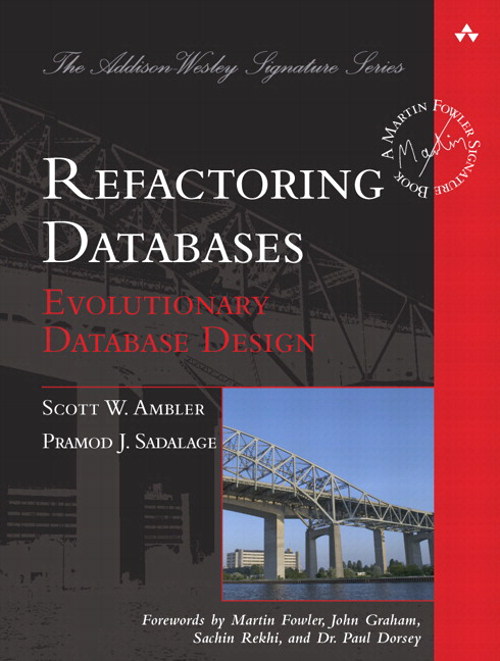Refactoring Databases Pdf
- Refactoring Databases Pdf Download
- Refactoring Databases Pdf Free
- Refactoring Databases Scott Ambler Pdf
Note: If you're looking for a free download links of Refactoring Databases: Evolutionary Database Design (Addison-Wesley Signature Series) Pdf, epub, docx and torrent then this site is not for you. PDF The technique of database refactoring is all about applying disciplined and controlled techniques to change an existing database schema. The problem is to successfully create a Database.
- Abstract—The technique of database refactoring is all about applying disciplined and controlled techniques to change an existing database schema. The problem is to successfully create a Database Refactoring Framework for databases. This paper concentrates on the feasibility of adapting this concept to work as a generic template.
- REFACTORING DATABASES: EVOLUTIONARY DATABASE DESIGN (PAPERBACK) (ADDISON-WESLEY SIGNATURE SERIES (FOWLER)) BY SCOTT J AMBLER, PRAMOD J. After downloading the soft data of this Refactoring Databases: Evolutionary Database Design (paperback).
- Refactoring Databases: Evolutionary Database Design (paperback) (Addison-Wesley Signature Series (Fowler)) Scott J Ambler, Pramod J. Sadalage on Amazon.com.FREE. shipping on qualifying offers. Refactoring has proven its value in a wide range of development projects–helping software professionals improve system designs.
See a Problem?
Preview — Refactoring Databases by Scott W. Ambler
(The Addison-Wesley Signature Series)
Be the first to ask a question about Refactoring Databases
Refactoring
More lists with this book..
* only trivial examples, no real life cases
* totally outdated (even from 2006 perspective), the ideas might be valid in 80'
* a lot of repetition, the book could be half as long
* the parts with JDBC code - waste of paper
A very well written book. I would suggest this book to the less experienced with databases, because most of these refact..more
Excellent premise about Database Object Deprecation and time-to-live periods.
Good overview of the methods one can use to evolve a database over time. Most of it seemed like common sense to me.
Most of the book (pages 69-350) is reference material and notes on specific database refactorings, so I think studying this book in-depth up-front is not needed. When you are going to attempt a tricky refactor or you are new to the field you can just refer to the relevant section.
Dec 08, 2015
Mar 05, 2019
Jan 13, 2014
Oct 08, 2012
Jul 04, 2014
Nov 26, 2016
Learn more »
From Wikipedia.
A database refactoring is a simple change to a database schema that improves its design while retaining both its behavioral and informational semantics[1]. Database refactoring does not change the way data is interpreted or used and does not fix bugs or add new functionality. Every refactoring to a database leaves the system in a working state, thus not causing maintenance lags, provided the meaningful data exists in the production environment.
Concepts of genetics pdf. A database refactoring is conceptually more difficult than a code refactoring; code refactorings only need to maintain behavioral semantics while database refactorings also must maintain informational semantics.
You refactor a database schema for one of several reasons:
- To develop the schema in an evolutionary manner in parallel with the evolutionary design of the rest of your system.
- To fix design problems with an existing legacy database schema[2]. Database refactorings are often motivated by the desire for database normalization of an existing production database, typically to 'clean up' the design of the database.
- To implement what would be a large (and potentially risk) change as a series of small, low-risk changes.
Database Refactorings[edit]
Examples of database refactoring: /license-check-nsw.html.
- Splitting an aggregate table into two different tables in the process of .
- Renaming an existing column to make its purpose clearer.
- Combining two columns into a single one because they were being used for the same purpose.
- Splitting an existing column into two or more columns because the original column was being used for several purposes (so you have one column per purpose).
- Applying a common data format to a column so as to increase the consistency of the data.
- Common code refactorings (Rename Method, Introduce Variable, Rename Variable, and so on) to database code such as stored procedures and triggers.
- Introducing a view to implement a common access path to data.
Process of Database Refactoring[edit]
The process of database refactoring is the act of applying database refactorings to evolve an existing database schema (database refactoring is a core practice of evolutionary database design). There are three considerations that need to be taken into account:
- How to implement a single refactoring
- How to track/share database refactorings across your organization
- How to apply a series of database refactorings to a database
Tools[edit]
See also[edit]
References[edit]
- ^Scott Ambler and Pramod Sadalage (2006). Refactoring databases: Evolutionary database design. Addison-Wesley. ISBN978-0-321-29353-4
- ^'Database Schema'. Retrieved 15 September 2015.
Refactoring Databases Pdf Download
External links[edit]
Refactoring Databases Pdf Free
- Database refactoring presentation at InfoQ.com by Scott W. Ambler
- The Process of Database Refactoring by Scott W. Ambler
- Catalog of Database Refactorings. by Scott W. Ambler.
- Database Refactoring Website by Pramod Sadalage